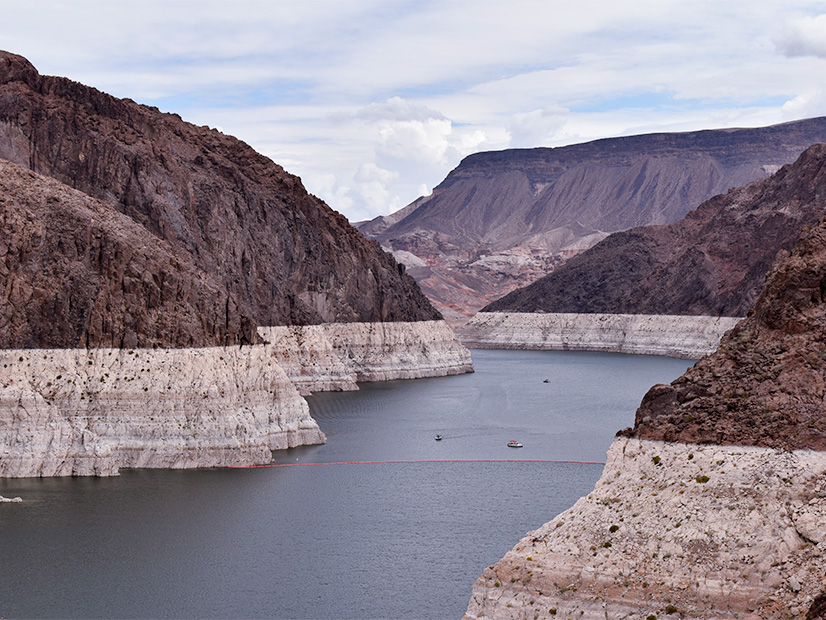Governors of the three states comprising the lower Colorado River Basin — California, Arizona and Nevada — announced Monday that they have agreed to a three-year water conservation plan aimed at protecting the drought-stricken Colorado River system.
The proposed plan still needs to go through a federal approval process, but if the Lower Basin Plan is approved, the three states would conserve at least an additional 3 million acre-feet of Colorado River water by the end of 2026, including at least 1.5 million acre-feet by the end of 2024.
Arizona Gov. Katie Hobbs, California Gov. Gavin Newsom and Nevada Gov. Joe Lombardo said the plan emphasizes substantial, near-term water conservation to reduce the risk of Lake Mead and Lake Powell dropping to critically low levels.
The plan would involve voluntary agreements with tribes, cities and agricultural water users in the three states, the governors said in a letter to Interior Secretary Deb Haaland.
“It’s never been more important to protect the Colorado River System, and this partnership is a critical next step in our efforts to sustain this essential water supply,” Lombardo said in a statement.
The conservation of up to 2.3 million acre-feet would be compensated through the federal Inflation Reduction Act, which includes drought mitigation funding. The remainder of the conserved water would be compensated by state or local entities — or be uncompensated.
“Thanks to the partnership of our fellow Basin states and historic investments in drought funding, we now have a path forward to build our reservoirs back up in the near-term,” Hobbs said in a statement.
But the Arizona governor noted that further action is needed to address the long-term issues of climate change and overallocation “to ensure we have a sustainable Colorado River for all who rely upon it.”
Review Process
The four states of the Colorado River’s Upper Basin — Colorado, New Mexico, Utah and Wyoming — joined the three Lower Basin states in sending a letter to Bureau of Reclamation Commissioner Camille Calimlim Touton, stating their support for submission of the Lower Basin Plan.
However, the Upper Basin States said they need time to thoroughly review the plan.
“Nothing in this letter should be construed as an Upper Basin endorsement of the Lower Basin Plan,” the letter states.
The submission of the Lower Basin Plan follows the Department of the Interior’s release last month of a draft supplemental environmental impact statement for near-term Colorado River operations. The comment period on the draft SEIS was scheduled to end on May 30.
But in response to the three states’ proposal, the department announced on Monday that it is withdrawing the draft SEIS. The Bureau of Reclamation plans to update the document to include analysis of the Lower Basin Plan as an action alternative. Officials expect to complete the SEIS process this year.
Risk Remains
A historic drought in the Colorado River Basin prompted the Bureau of Reclamation to declare its first water shortage for Lake Mead in 2021. The declaration meant water supply cutbacks to Arizona, Nevada and Mexico. Another Lake Mead shortage was declared last year.
Last month, Reclamation announced above-average projections for this water year and said downstream flows from Lake Powell to Lake Mead would be increased.
But “despite this year’s welcomed snow, the Colorado River system remains at risk from the ongoing impacts of the climate crisis,” Touton said.
According to the Interior Department, 40 million people, seven states, and 30 tribal nations depend on the Colorado River for drinking water and electricity.
Glen Canyon Dam at Lake Powell and Hoover Dam at Lake Mead generate on average 5 billion KWh and 4 billion KWh a year, respectively. As recently as this winter, federal water officials were warning that Lake Mead could reach the “dead pool” level for hydroelectric generation by 2025, with Lake Powell close behind, but conditions have improved.
According to the letter from the three governors, modeling shows that the Lower Basin Plan would provide greater protection for Lake Mead and Lake Powell than the alternatives analyzed in the draft SEIS.
The Lower Basin Plan would also allow the Basin states and the Bureau of Reclamation to turn its focus to Colorado River operations after 2026, the letter said.



